Physical Address
304 North Cardinal St.
Dorchester Center, MA 02124
Physical Address
304 North Cardinal St.
Dorchester Center, MA 02124
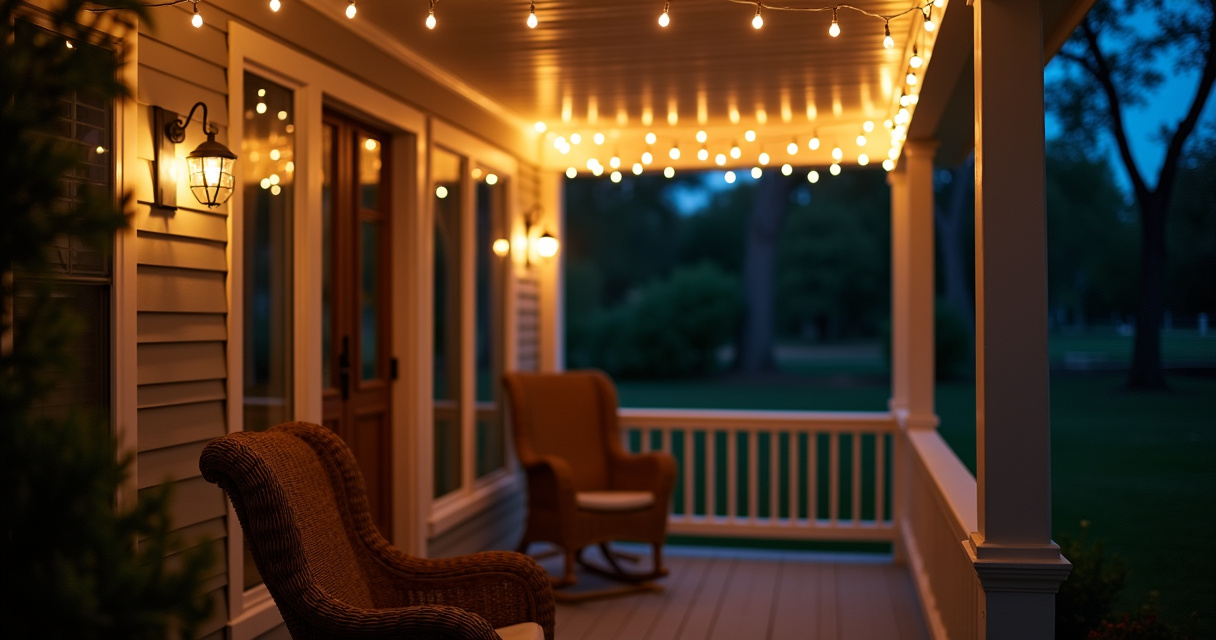
Is your back porch just sitting there unused? A forgotten threshold between your home and the natural world outside?
What if I told you that with some thoughtful back porch decorating, this overlooked space could become your favorite spot to unwind, entertain friends, or simply enjoy your morning coffee surrounded by nature?
Back porch decorating isn’t about major renovations or spending a fortune. It’s about smart choices and creative touches that transform this transitional space into a true extension of your home. With the right approach, your back porch can become an outdoor sanctuary that reflects your style while embracing the natural world.
Ready to fall in love with your back porch? Let’s explore 20 stunning decorating ideas that will inspire you to reimagine this space. From comfortable seating to enchanting lighting and everything in between, get ready to unlock your back porch’s full potential.
But here’s the thing about outdoor seating – durability matters just as much as comfort. For a back porch that’s exposed to the elements, look for sofas with frames made from all-weather wicker, teak, aluminum, or powder-coated steel. These materials, when paired with cushions covered in solution-dyed acrylic or olefin fabrics, resist fading, mildew, and moisture damage, ensuring your cozy spot remains beautiful for years.
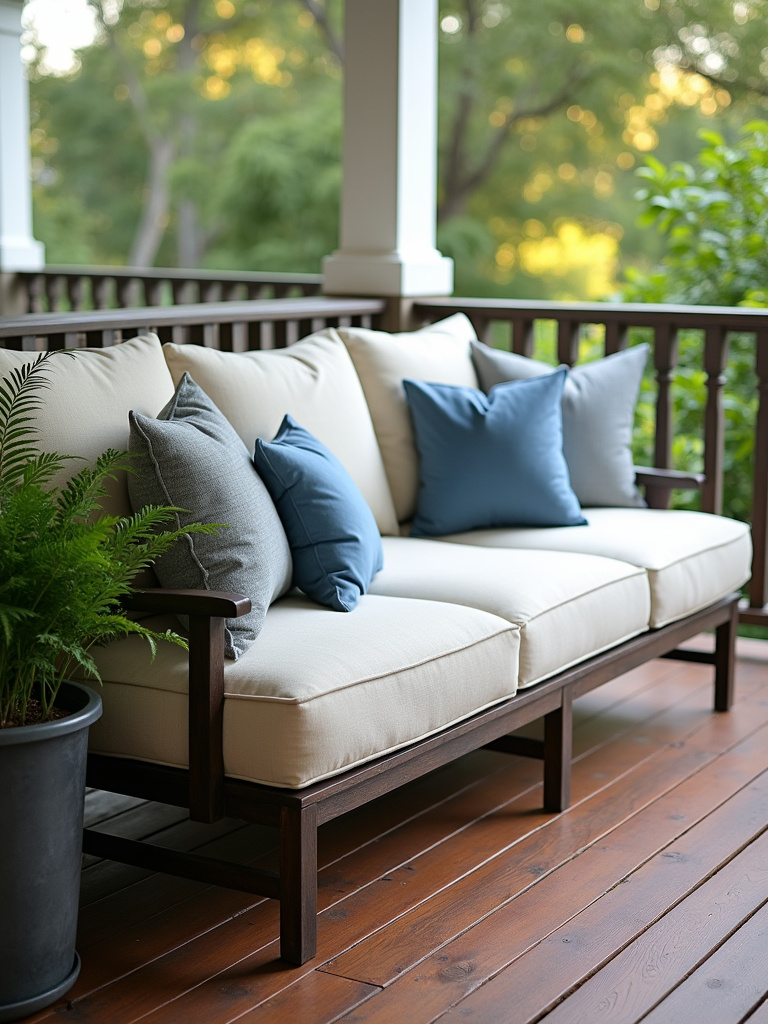
Working with a smaller back porch? Scale is key. Consider a loveseat or compact sofa instead of a full-sized one. Position it against a wall or railing to maximize your floor space. For corner spaces, L-shaped or sectional pieces can fit snugly, providing ample seating without overwhelming the area. Creating a modular arrangement with individual pieces offers flexibility for different occasions – perfect for entertaining or simply rearranging for a fresh perspective.
The surprising part is that outdoor sofas are a relatively modern invention, despite the concept of sofas dating back to ancient Egypt. Today’s weather-resistant versions are the result of significant advancements in material science, making outdoor comfort more accessible than ever for your back porch decorating projects.
Here’s where it gets interesting – string lights aren’t just about illumination; they’re about creating atmosphere. For back porch decorating, they’re transformative, turning ordinary evenings into magical experiences. But hanging them requires some consideration. To avoid damaging your porch structure, use damage-free adhesive hooks, zip ties, or guide wires strung between secure points like posts or rafters. These methods minimize the need for permanent fixtures while ensuring your lights stay securely in place.
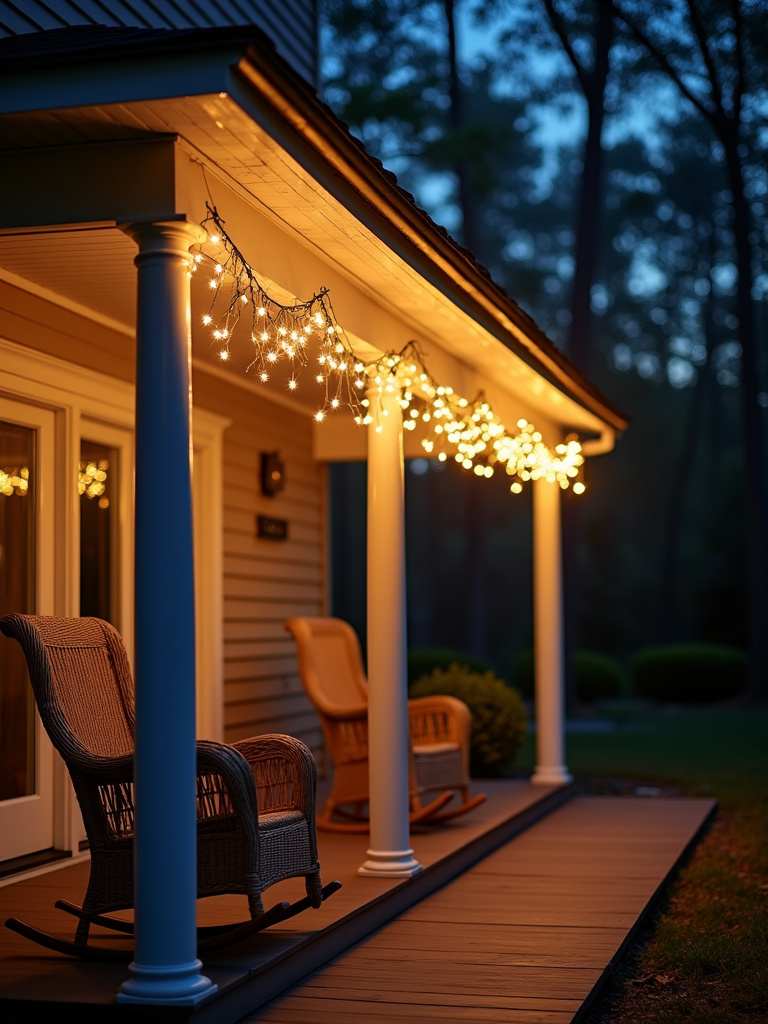
When selecting string lights for your back porch, durability should be your priority. Opt for LED string lights specifically rated for outdoor use. Look for waterproof or weather-resistant options (those UL listed for wet locations are ideal). LED lights not only consume less energy than incandescent bulbs but also last significantly longer, saving you the hassle of frequent replacements and ensuring consistent ambiance night after night.
The key thing to understand is that string lights offer endless creative possibilities for your back porch decorating. Don’t just run them along the roofline – weave them through railings, drape them around plants, or create a canopy effect across the ceiling. These layers of light create depth and dimension, enhancing your porch’s atmosphere and extending its usability well into the evening hours.
I’ll break this down – potted plants are essential for successful back porch decorating because they bridge the gap between your home and nature. They bring life, color, texture, and even fragrance to your outdoor space. But choosing the right plants for your specific porch conditions is crucial. For shadier areas, consider ferns, snake plants, ZZ plants, and hostas, which thrive with less direct sunlight. If your porch enjoys more sunshine, geraniums, petunias, lavender, and herbs like rosemary and thyme will flourish and provide both beauty and function.
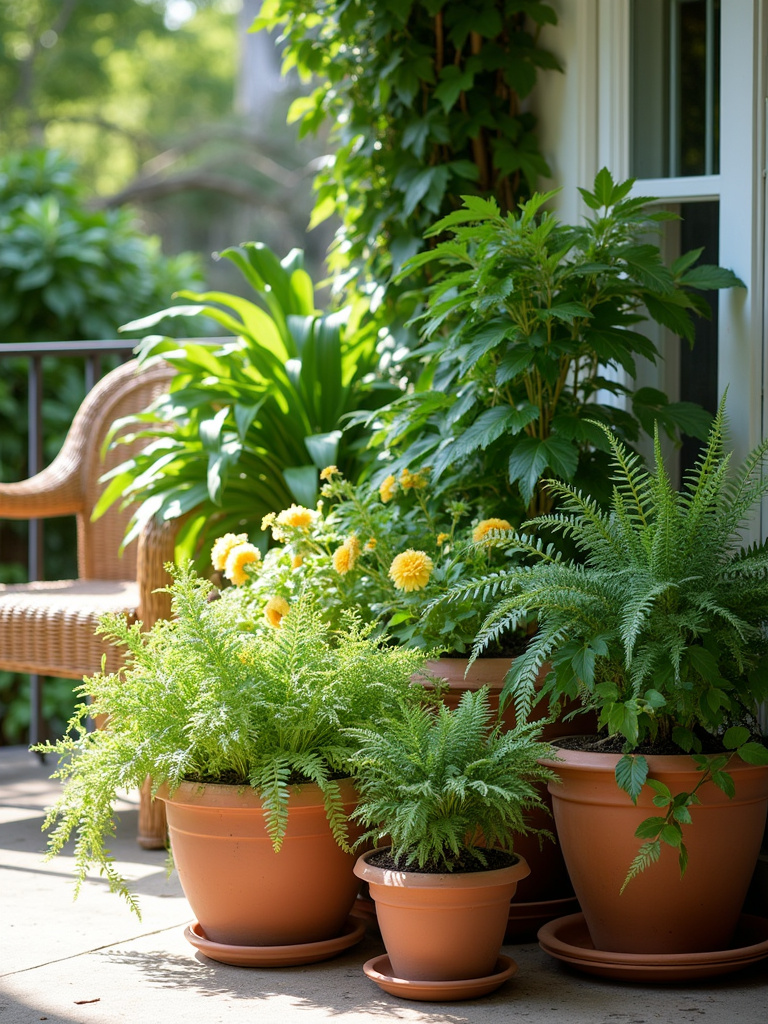
The container you choose is just as important as the plant itself. Select pots that accommodate the mature size of your plants and ensure they have proper drainage holes. Terracotta pots are classic and breathable but dry out more quickly, while plastic or glazed ceramic pots retain moisture better. Consider both the practical needs of your plants and how the pot material and color will complement your overall back porch decorating scheme.
What’s truly fascinating is that plants do more than just beautify your space – they improve air quality by absorbing pollutants and releasing oxygen. Research has shown that gardening, even in containers, reduces stress and improves mood. This makes your planted back porch not just visually appealing but also a place that actively contributes to your wellbeing.
Picture it this way: your back porch is essentially an outdoor room, and like any room, the flooring plays a crucial role in tying the space together. An outdoor rug instantly adds warmth, comfort, and style underfoot, transforming bare porch floors from cold and uninviting to cozy and defined. For materials that can withstand weather and foot traffic, polypropylene, olefin, and PET (recycled plastic) are excellent choices. These synthetic fibers resist water, fading, and stains while being easy to clean – essential qualities for successful back porch decorating.

Selecting the right size and style for your outdoor rug requires balancing proportion and personality. Ideally, your rug should extend slightly beyond your furniture grouping, anchoring the space and creating a cohesive look. Color-wise, you can either complement your existing porch elements for a harmonious feel or introduce contrasting patterns and hues for visual interest. Remember that your rug isn’t just functional – it’s a design statement that reflects your style and helps define your outdoor living space.
Do you see how huge that is? An outdoor rug doesn’t just add comfort; it completely transforms how your back porch feels and functions. It visually defines seating areas, adds a layer of insulation between you and cold flooring, protects your porch surface, and instantly elevates the entire aesthetic of your outdoor space.
Let me paint you a picture of the perfect back porch retreat – a gently swaying hammock swing, creating an instant relaxation zone in an otherwise unused corner. For back porch decorating, hammock swings offer a wonderful space-efficient alternative to full hammocks or bulky furniture. Chair hammocks (with single-point suspension) are often ideal for porches, requiring just one secure hanging point. This makes them easier to install than spreader bar hammocks or traditional two-point suspension hammocks, which need more space and two anchor points.
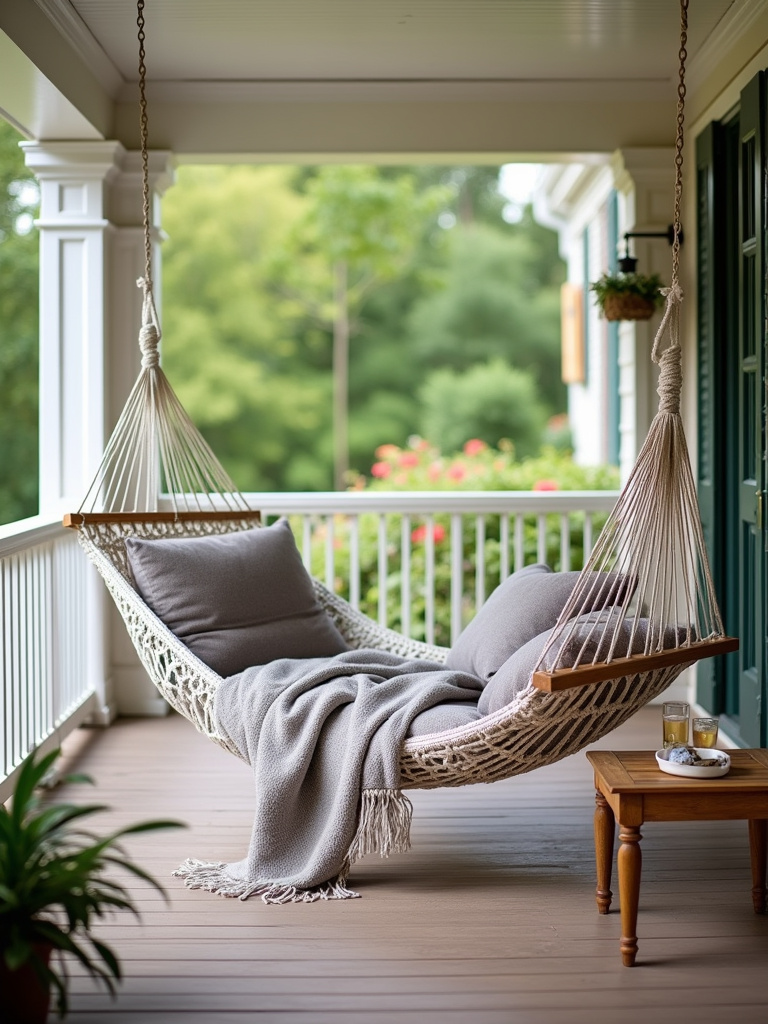
Safety is paramount when installing any hanging furniture. Identify a sturdy structural element like a porch beam or rafter – this is non-negotiable. Use heavy-duty hooks or mounting hardware specifically rated for the weight capacity of both the hammock and its occupants. Ensure the hardware is securely attached to the structural element and test it carefully before fully using it. If you’re uncertain about installation, consulting a professional is worth the investment for both safety and peace of mind.
The root cause of a hammock swing’s appeal in back porch decorating goes beyond aesthetics. Research shows that the gentle swinging motion has genuine therapeutic benefits, promoting relaxation and reducing stress. This makes your hammock swing not just a beautiful addition, but a wellness feature that enhances your overall porch experience.
This is where everything changes in your back porch decorating after sunset. Elegant outdoor lanterns create layers of warm, inviting light that transform your porch from a daytime retreat to an enchanting evening haven. When selecting lanterns, consider your power options: battery-operated lanterns offer convenience and portability, solar-powered ones provide eco-friendly illumination, and electric lanterns deliver consistent power but require wiring. For most back porches, battery and solar options offer the greatest flexibility without electrical complications.
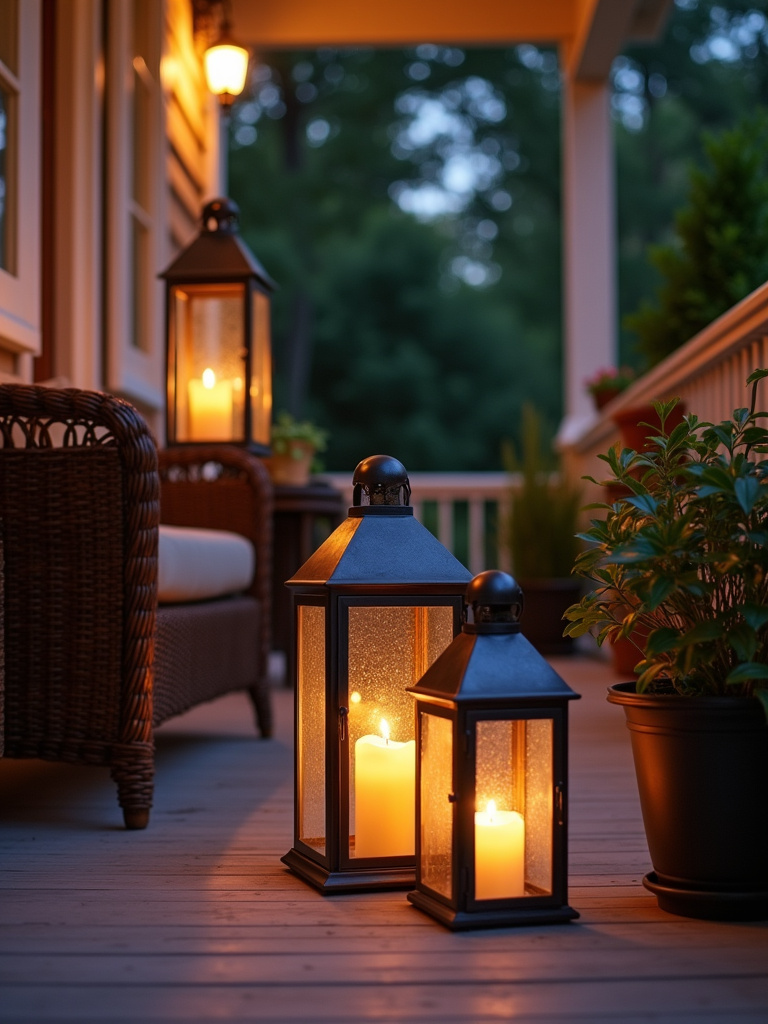
Creating different lighting moods with lanterns is an art that elevates your back porch ambiance. Use lanterns with dimmable features or varying brightness levels to adjust the atmosphere from bright and energetic to soft and intimate. Group lanterns of different sizes together for visual interest, and place them at varying heights – tabletop, hanging, and floor-standing – to create dimension. Warm white light creates a cozy, welcoming ambiance, while cooler tones can provide brighter task lighting when needed for reading or dining.
The heart of the matter is that lanterns have been used for outdoor illumination for centuries, evolving from simple oil lamps to today’s diverse designs. Their enduring appeal lies in their ability to create a sense of intimacy and warmth that overhead lighting simply cannot match – a perfect element for thoughtful back porch decorating that considers both day and nighttime enjoyment.
Let’s unpack this essential element of back porch decorating – throw pillows are the easiest way to infuse personality, comfort, and color into your outdoor seating. However, indoor pillows won’t survive the elements. For truly weatherproof options, look for pillows made with solution-dyed acrylic (like Sunbrella), olefin, or polyester fabrics. These materials resist fading from sun exposure, repel moisture, prevent mildew growth, and stand up to daily use, ensuring your porch remains inviting and vibrant throughout the seasons.
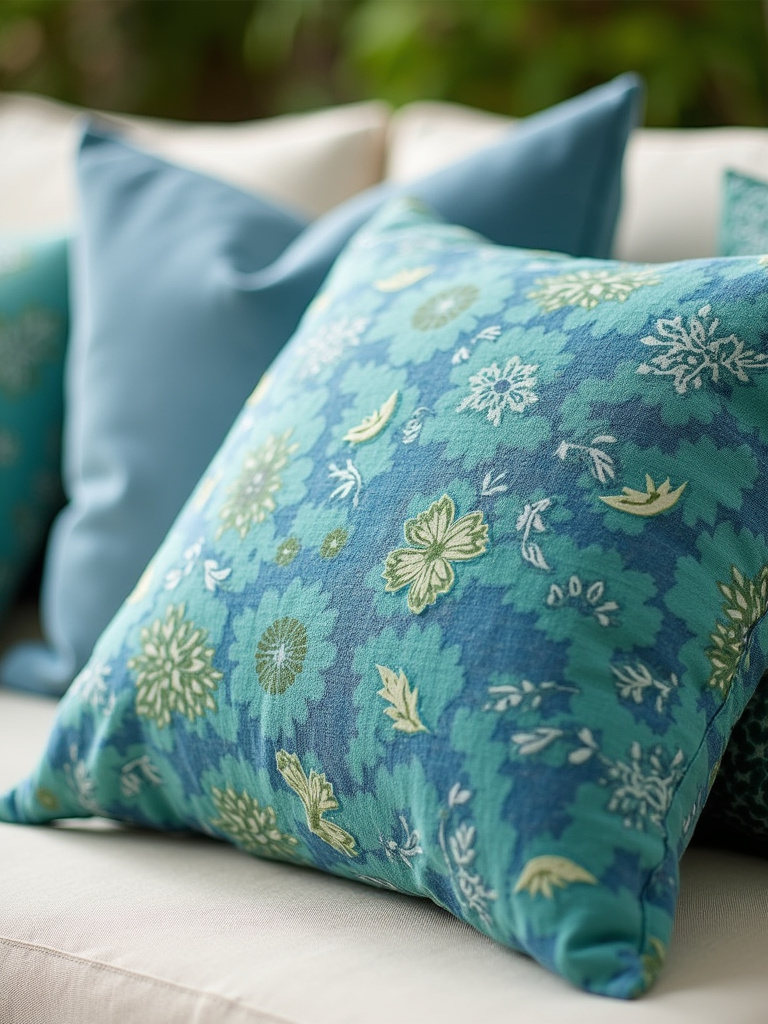
Selecting colors and patterns for your throw pillows is where your personal style truly shines in your back porch decorating. Start by considering your existing furniture and décor colors – do you want pillows that harmonize with this palette or provide striking contrast? Patterns add visual interest and texture; stripes create a classic look, while florals or geometric designs can make a bold statement. Don’t be afraid to mix and match different sizes and shapes – combining square, rectangular, and round pillows creates a layered, professionally designed appearance.
The game-changer happened as I realized that throw pillows aren’t just accessories – they’re the most affordable and flexible way to refresh your back porch seasonally. Swapping pillows requires minimal effort but delivers maximum impact, allowing you to update your outdoor space from spring blooms to autumn warmth without replacing furniture or major décor elements.
The breakthrough came when designers realized that back porch decorating didn’t have to be limited to horizontal spaces. Vertical gardens allow you to transform blank walls into living tapestries of green, maximizing your planting space without consuming precious floor area. This innovation is particularly valuable for smaller porches where traditional planters might create clutter. With vertical gardens, you can introduce abundant plant life while maintaining an open, spacious feel.
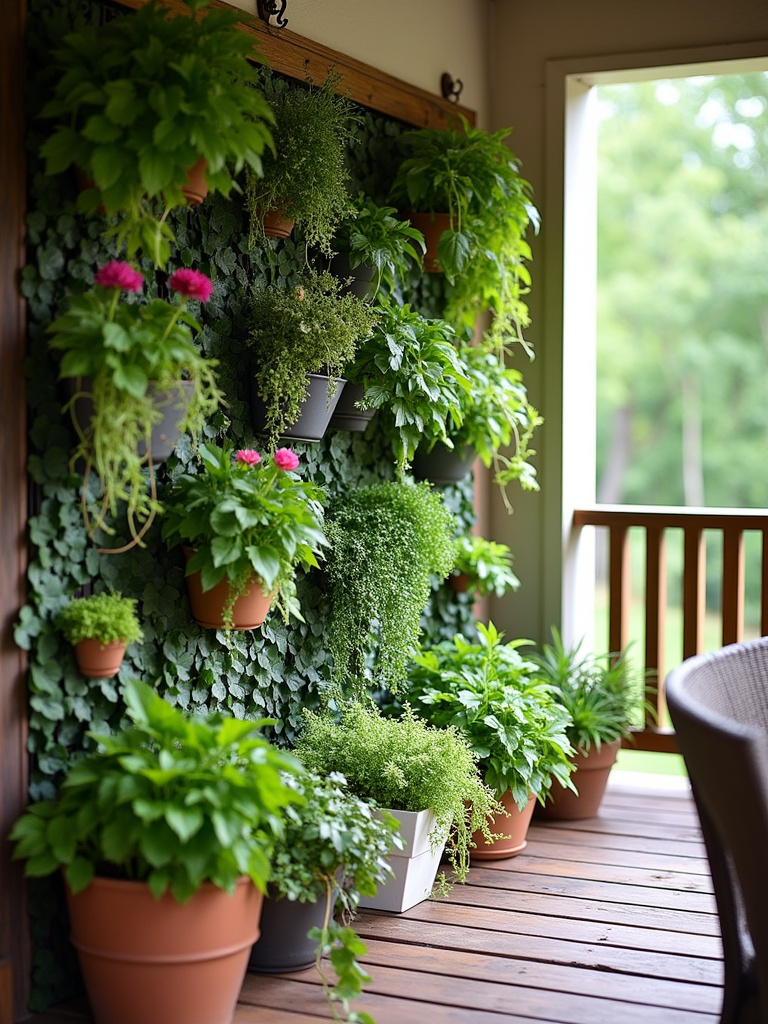
Plant selection for vertical gardens depends primarily on your porch’s light conditions. For sunny spots, herbs, succulents, strawberries, and flowering vines thrive and create dramatic visual interest. Shadier porches call for ferns, hostas, begonias, and leafy greens. The key to success is grouping plants with similar water and light requirements together. Structure options include wall-mounted planters, hanging pocket systems, tiered stands, repurposed pallets, or custom frameworks of wood or wire mesh – choose what best suits your aesthetic and the architecture of your porch.
What’s really at play here with vertical gardens in back porch decorating is more than aesthetics. These living walls can serve as natural insulators, reducing noise pollution and creating a cooler microclimate around your porch. They transform ordinary walls into functional ecosystems that benefit both your outdoor living experience and the environment.
Now, consider this essential element of back porch decorating – your entryway sets the first impression, and a well-chosen welcome mat serves as both a practical necessity and a style statement. For materials that can withstand outdoor conditions, especially in wet or high-traffic areas, look to coir (coconut fiber), rubber, and polypropylene. Coir excels at scraping dirt from shoes, rubber provides excellent weather resistance and stability, and polypropylene resists mildew – making it perfect for humid environments. Each material offers distinct advantages depending on your local climate and porch exposure.
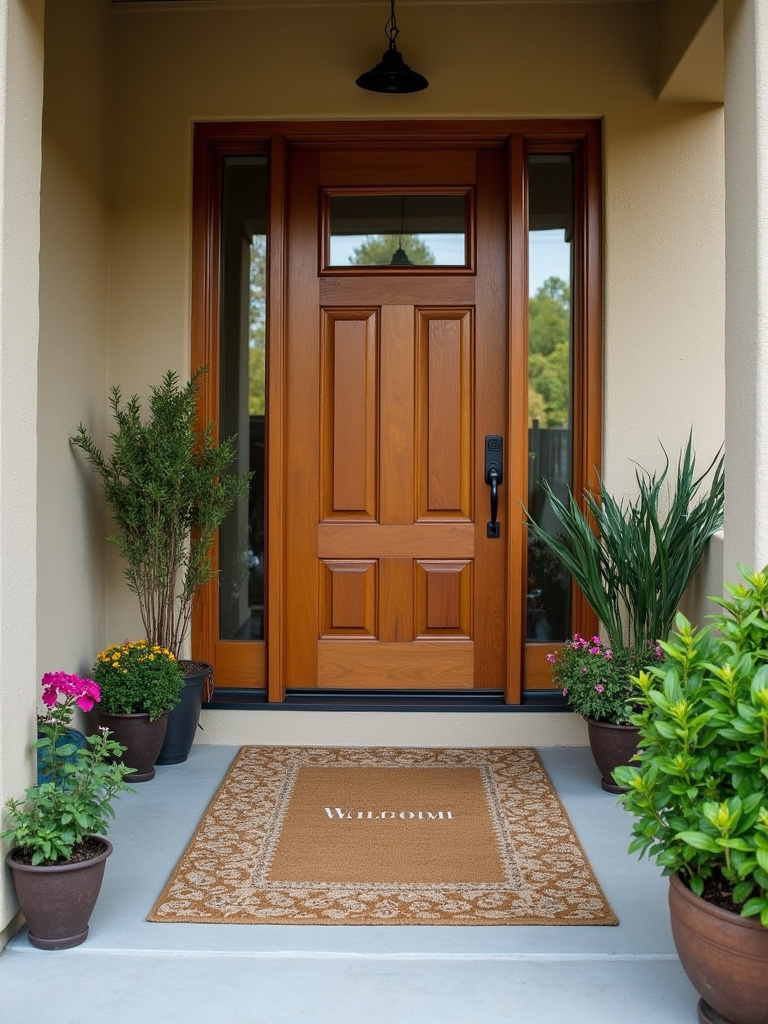
Finding the balance between functionality and style is the art of welcome mat selection. Consider how the mat complements your overall back porch decorating scheme in terms of color, pattern, and material. A rustic porch might call for a natural coir mat with simple designs, while a more contemporary space could benefit from a sleek rubber mat with geometric patterns. Size matters too – choose a mat proportional to your entryway, neither overwhelming the space nor appearing too small for the doorway it serves.
This all connects because your welcome mat isn’t just a practical item – it’s a transition point between the outside world and your personal outdoor sanctuary. It both protects your porch from tracked-in dirt and welcomes visitors with a touch of your personal style, making it an essential consideration in thoughtful back porch decorating.
The process goes like this when transforming blank walls on your back porch: think beyond indoor-only decoration and consider weather-resistant wall art that adds personality and visual interest to vertical spaces. For back porch decorating, choosing art made from durable materials is essential. Look for pieces crafted from powder-coated aluminum, stainless steel, treated wood, resin, or outdoor-rated canvas prints. These materials withstand moisture, sunlight, and temperature fluctuations while maintaining their beauty season after season.
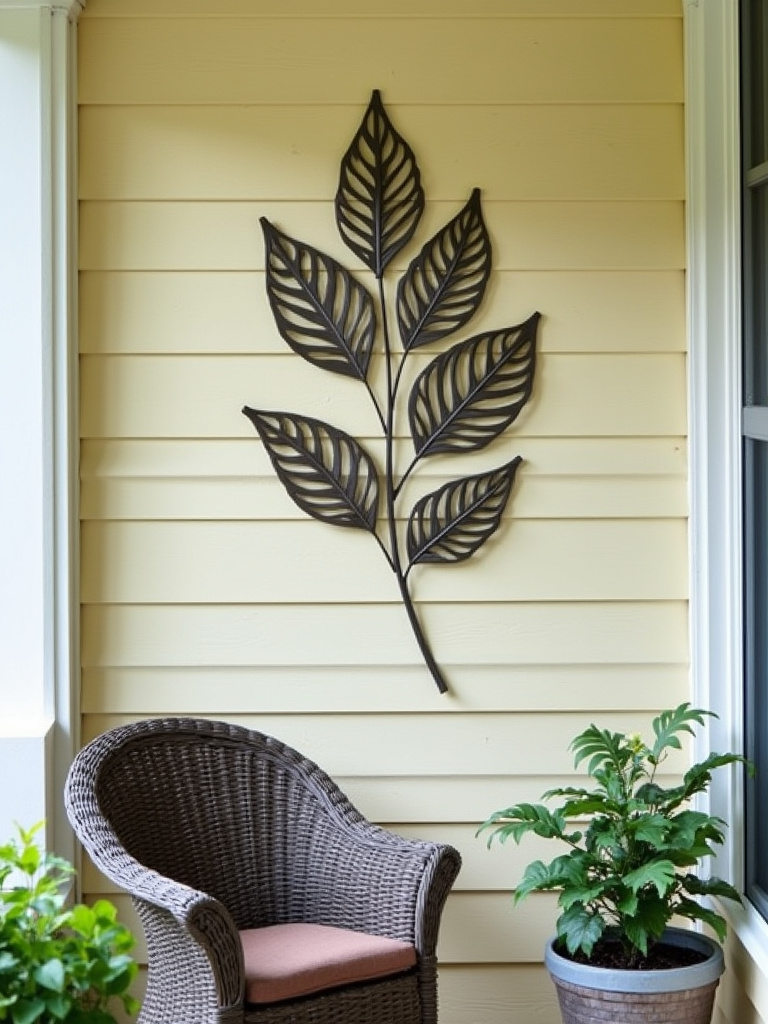
Selecting art that complements your back porch style requires considering both durability and aesthetic cohesion. Think about your porch’s overall theme – is it coastal, rustic, modern, or eclectic? Choose subject matter, colors, and materials that resonate with this established style. For instance, metal botanical cutouts might suit a garden-inspired porch, while abstract aluminum pieces could complement a more contemporary space. The key is finding pieces that not only withstand the elements but also reflect your personal taste and enhance your outdoor environment.
What complicates this aspect of back porch decorating is finding the balance between protection and prominence. While it’s ideal to place wall art in areas somewhat protected from direct weather exposure (under eaves or on covered portions of the porch), you also want pieces visible enough to make an impact. This tension between protection and visual prominence requires thoughtful placement that considers both preservation and aesthetic effect.
What many people overlook when selecting wicker furniture for back porch decorating is the critical distinction between natural and synthetic materials. Not all wicker is suitable for outdoor exposure. Natural wicker made from rattan or reed offers authentic charm but requires protection from direct weather on covered porches. For exposed areas, all-weather wicker made from synthetic resin or polyethylene provides the same aesthetic appeal with significantly enhanced durability against sun, rain, and temperature variations.
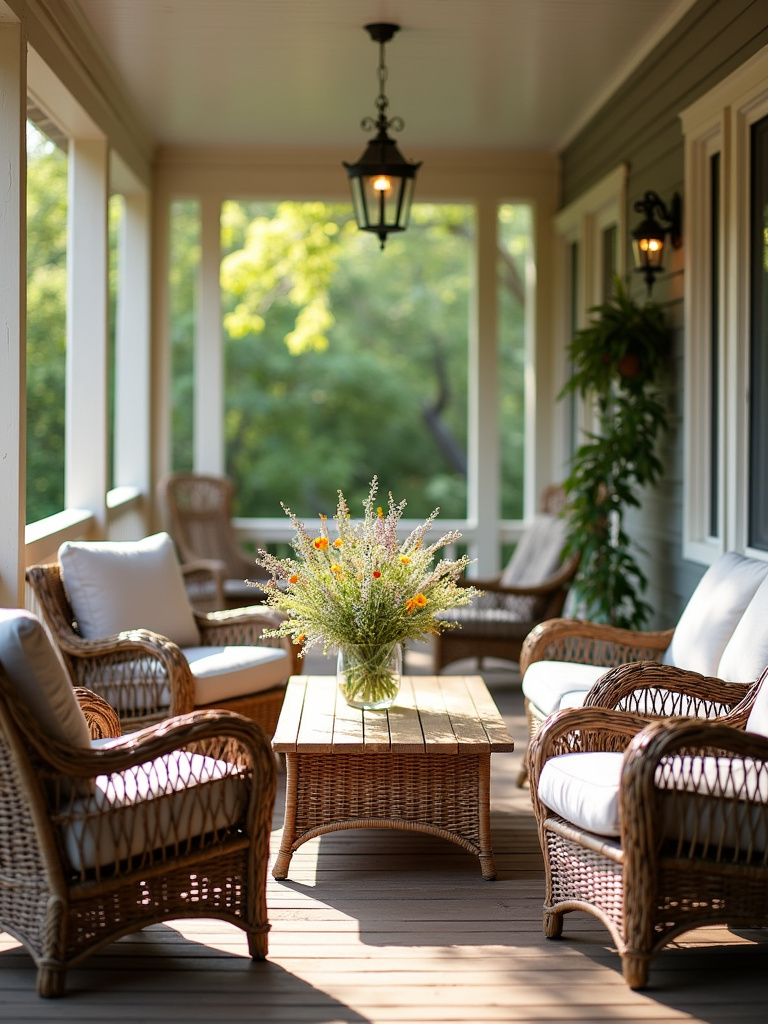
Styling wicker to achieve a rustic yet contemporary look involves thoughtful color and texture pairings. Natural or light-toned wicker pieces create a bright, airy foundation. Pair them with neutral or earth-toned cushions and throws in natural fabrics like linen or cotton for an organic feel. To prevent your back porch decorating from looking dated, balance rustic wicker with more modern elements – clean-lined metal accessories, minimalist lighting fixtures, or sleek side tables provide contemporary contrast while maintaining the overall warm and inviting atmosphere.
The process unfolds like this – regular maintenance keeps your wicker furniture looking its best through the seasons. Clean natural wicker with a soft brush or vacuum to remove dust and debris, using mild soap and water sparingly for deeper cleaning. For synthetic wicker, while more weather-resistant, protective covers can still extend its lifespan and preserve its appearance, especially during extreme weather or winter months.
Here’s the inside story on what makes storage solutions essential for back porch decorating – they’re the unsung heroes that keep your outdoor space functional and uncluttered. For weatherproof and stylish options that blend seamlessly with your décor, consider multi-functional pieces like deck boxes that double as benches or side tables, storage ottomans that provide both seating and hidden storage, or outdoor-rated cabinets and consoles. Look for materials specifically designed for outdoor durability – resin, treated wood, or powder-coated metal will withstand the elements while maintaining their appearance.
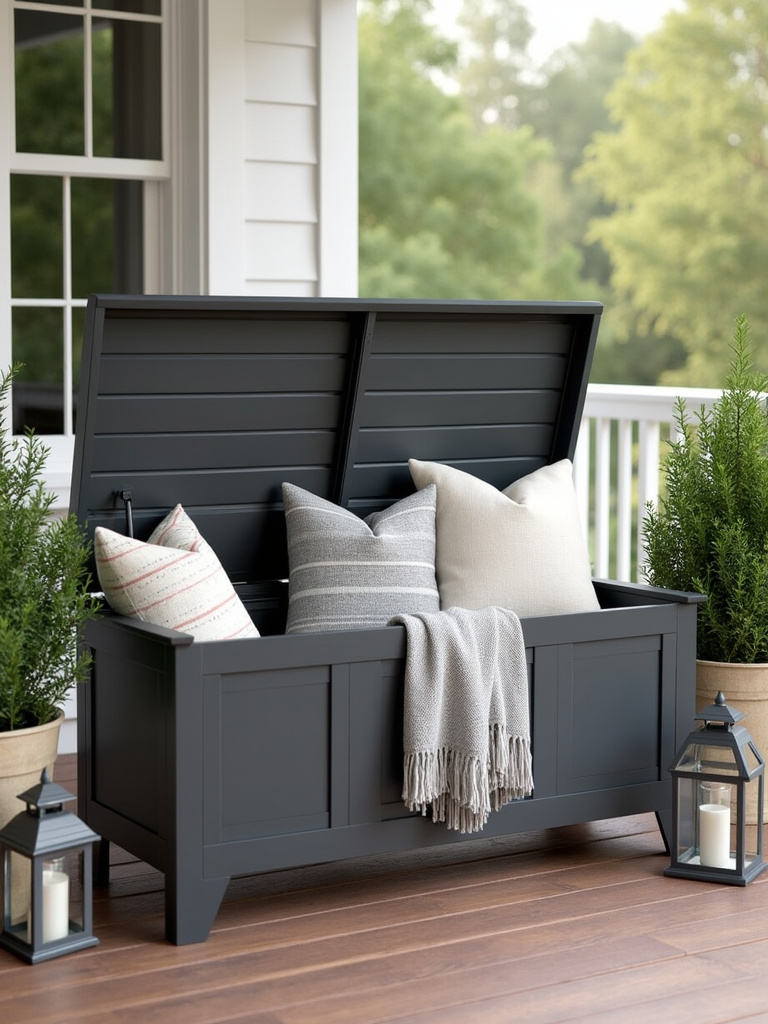
Incorporating storage discreetly on a smaller back porch demands strategic thinking. Focus on multi-purpose furniture that serves dual roles – a bench with under-seat storage or a coffee table with lift-top compartment maximizes functionality without consuming extra space. Vertical storage solutions like wall-mounted cabinets or narrow shelving units utilize overlooked wall space. For visual cohesion in your back porch decorating, select storage pieces in colors and styles that complement your existing furniture, helping them blend rather than stand out as utilitarian additions.
What’s fascinating is how thoughtful storage solutions actually enhance rather than detract from your back porch aesthetics. By eliminating clutter – stray cushions, gardening tools, outdoor games – storage creates a more organized and visually pleasing environment. Your porch transforms from a chaotic catch-all to a purposeful outdoor room designed for relaxation and enjoyment.
The key factor here in effective back porch decorating is understanding that statement planters aren’t just containers – they’re architectural elements that define and elevate your space. For maximum impact, consider oversized terracotta pots with their timeless warmth, tall ceramic planters in bold colors or patterns, weathered stone or concrete vessels with their substantial presence, or repurposed vintage containers like metal tubs or wooden barrels that add character and history. The common thread among effective statement planters is their ability to command attention through size, color, texture, or unique design.
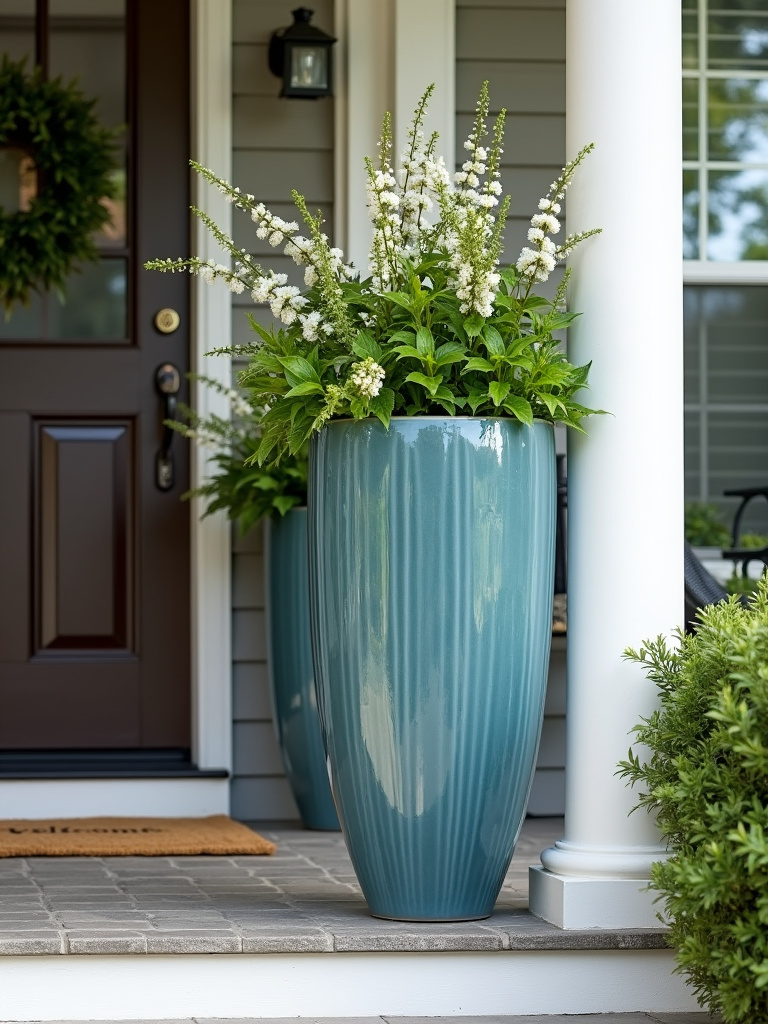
Plant selection for your statement planter is just as crucial as the container itself. To create a truly captivating focal point in your back porch decorating, choose plants with bold visual characteristics – dramatic height, striking foliage, unusual form, or vibrant blooms. Small trees like citrus or olive varieties bring elegant structure, while tall ornamental grasses add movement and sound. Flowering plants like hydrangeas or bird of paradise provide vibrant color, while sculptural succulents offer fascinating geometric forms. Consider adding cascading plants around the edges to soften the planter’s lines and create vertical dimension.
The bottom line here is that a well-designed statement planter serves as living art for your back porch. Unlike static decorative elements, it changes throughout the seasons – growing, blooming, and evolving while maintaining its role as a central visual anchor in your outdoor space.
Let me show you another perspective on back porch decorating – outdoor curtains offer more than just privacy; they transform an open porch into an intimate outdoor room with defined boundaries and a sense of enclosure. For fabrics that can withstand the elements while providing the desired level of privacy, outdoor-rated polyester, acrylic, and olefin are superior choices. These materials resist water damage, color fading from sun exposure, and mildew growth. The fabric’s weave and weight determine privacy levels – lightweight sheers filter light and provide minimal privacy, while heavier fabrics offer more substantial screening from neighboring views.
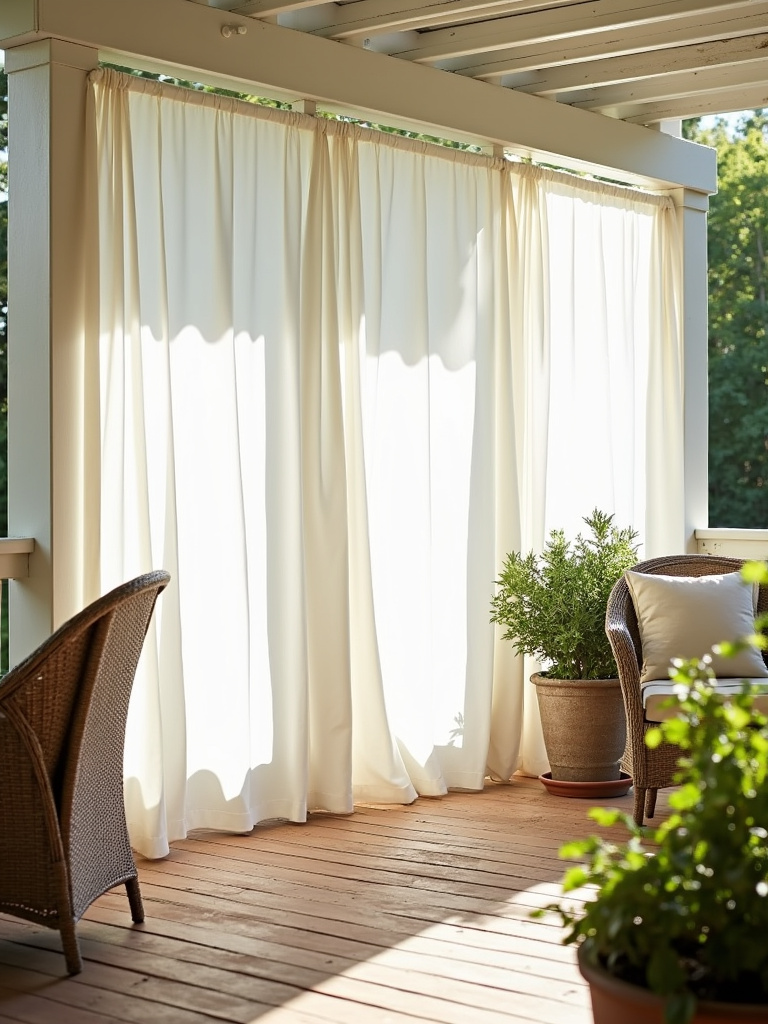
Installing outdoor curtains effectively requires both function and style considerations. Use outdoor-rated curtain rods or wires mounted securely to porch posts or rafters with hardware designed to withstand outdoor conditions. Grommet-top curtains offer a clean, modern aesthetic and easy operation, while tab-top or tie-top styles create a more casual, relaxed look. For practical back porch decorating, add ties or weights to control curtain movement on breezy days and to adjust the level of privacy and light as needed throughout the day.
Beyond privacy, this changes everything though – outdoor curtains serve multiple functions in your back porch environment. They provide shade from harsh sunlight, reduce heat, block some wind, and create distinct zones within your porch. This versatility makes them one of the most functional decorative elements you can incorporate into your outdoor space.
The crucial point is safety when incorporating a fire pit into your back porch decorating. Different types offer varying levels of convenience and security. Wood-burning fire pits provide traditional crackling flames and aroma but produce more sparks and require more monitoring. Propane fire pits offer cleaner burning with convenient ignition and adjustment controls. Natural gas fire pits, while requiring permanent installation, provide the ultimate convenience with constant fuel supply. For most porches, especially wooden ones, propane and natural gas options are safest as they produce fewer stray embers. Always verify local fire codes and ensure your porch materials are compatible with your chosen fire pit.

Creating a cozy gathering space around your fire pit involves thoughtful arrangement of your back porch furnishings. Position the fire pit as a central focal point with seating arranged in a conversational circle around it. Define this area visually using an outdoor rug or different flooring material to create a distinct zone. Add ambient lighting like string lights or lanterns to enhance the evening atmosphere. Include accessible side tables for drinks and snacks, making the space both comfortable and functional for entertaining or quiet evenings outdoors.
It all boils down to this – a fire pit transforms your back porch from a fair-weather space to a year-round retreat. The warmth extends your outdoor enjoyment into cooler evenings and seasons, while the mesmerizing quality of flames creates an ambiance that no other feature can replicate – making it one of the most impactful additions in back porch decorating.
Here’s how it works when incorporating hanging baskets into your back porch decorating – they bring eye-level color and life while utilizing vertical space that often goes unused. Plant selection depends on your porch’s light conditions. For sunny locations, vibrant bloomers like petunias, geraniums, calibrachoa (million bells), and verbena create dramatic cascades of color. If your porch receives primarily shade, opt for fuchsias, begonias, impatiens, and trailing ivy with their lush foliage and shade-tolerant flowers. Consider seasonal changes too – pansies and violas thrive in cooler weather, while heat-tolerant coleus and sweet potato vine provide summer-long color.
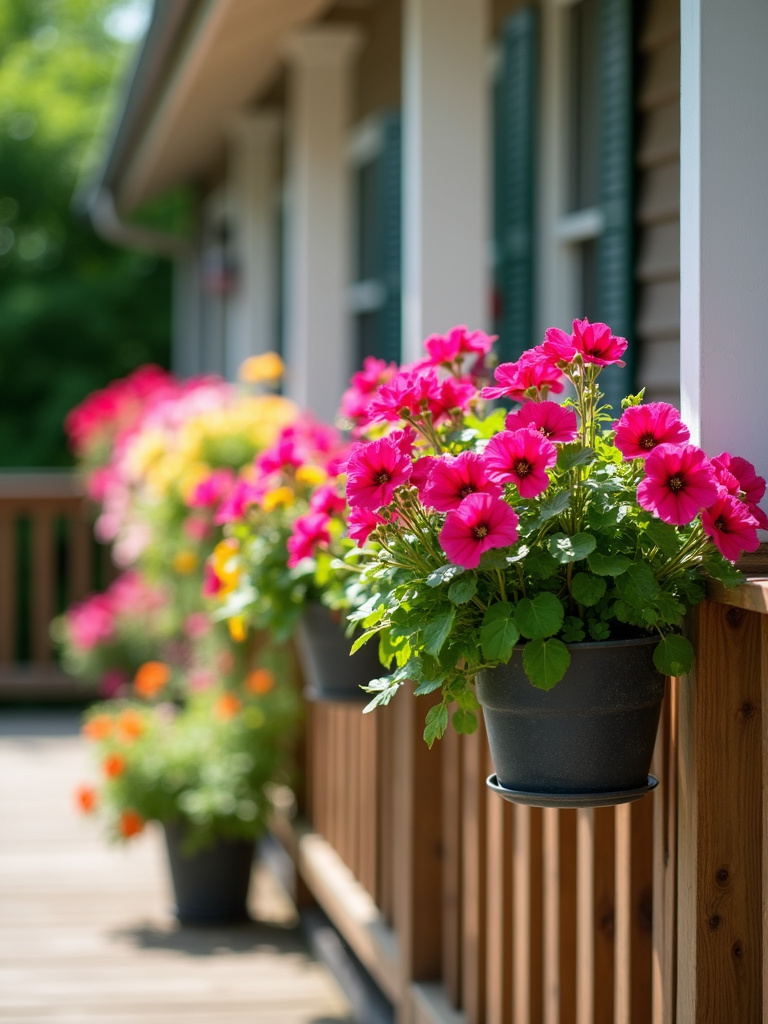
The container itself contributes significantly to your back porch aesthetics. Wire baskets lined with coco coir offer classic garden style with excellent drainage. Plastic or resin baskets provide lightweight durability in various colors and designs to complement your décor. Wicker or natural fiber baskets add organic texture but may require plastic liners to retain moisture. Consider self-watering models for easier maintenance, especially in hot climates. The right combination of container and plants creates living sculptures that add dimension and movement to your back porch decorating.
This reminds me of how Victorian gardeners used hanging baskets to bring nature closer to their living spaces – a tradition that continues today because it works so beautifully. Beyond aesthetics, hanging baskets attract pollinators like butterflies and hummingbirds, adding another layer of life and movement to your back porch environment.
The fundamental truth is that entertaining outdoors becomes infinitely easier with a dedicated drink station as part of your back porch decorating strategy. Several furniture options can serve this purpose beautifully. Bar carts on wheels offer mobility and vintage charm, allowing you to move your refreshments where needed. Outdoor consoles or sideboards provide generous surface area and storage beneath. Built-in bars represent a more permanent but luxurious solution for frequent entertainers. Even a simple sturdy table can transform into an effective drink station with thoughtful organization and accessories.
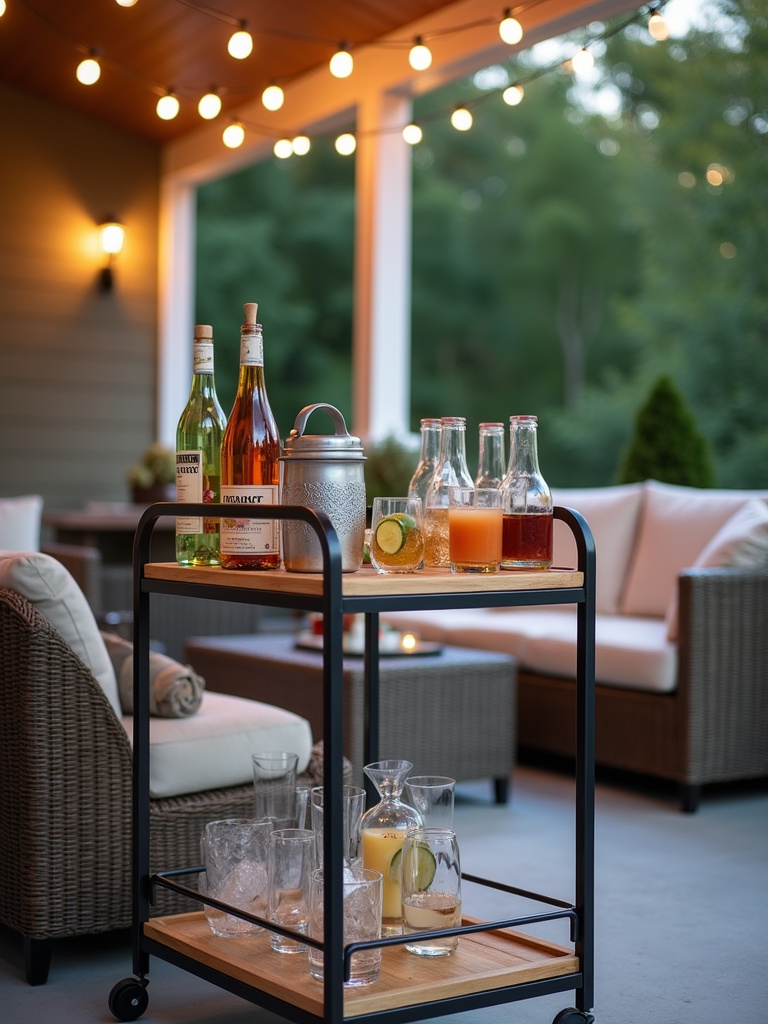
Stocking your outdoor drink station requires consideration of both practicality and presentation. Essential items include an ice bucket or cooler, drink dispensers or pitchers for easy serving, appropriate glassware for various beverages, and cocktail tools if you’ll be mixing drinks. Don’t forget practical elements like napkins, coasters, straws, and a small waste receptacle. Consider adding fresh garnishes like citrus slices or herbs from your garden. For a polished back porch decorating touch, arrange items on attractive trays or tiered stands to create visual interest while keeping everything organized.
“A well-designed drink station doesn’t just serve beverages – it creates a natural gathering point that encourages conversation and connection while keeping the host free to enjoy their guests instead of running back and forth to the kitchen.”
I’ll walk you through the essential elements that define farmhouse style in back porch decorating. This aesthetic centers around natural materials with character and history. Reclaimed wood brings warmth and authenticity through weathered textures. Galvanized metal accents – from planters to lanterns – add an industrial-rustic touch. Natural fabrics like burlap, linen, and cotton introduce organic texture. Decorative touches like mason jars, vintage lanterns, and wooden crates reference traditional farm life. The color palette typically features neutrals (whites, creams, grays) with occasional soft colors as accents. Throughout these elements runs a common thread of simplicity, functionality, and unpretentious charm.
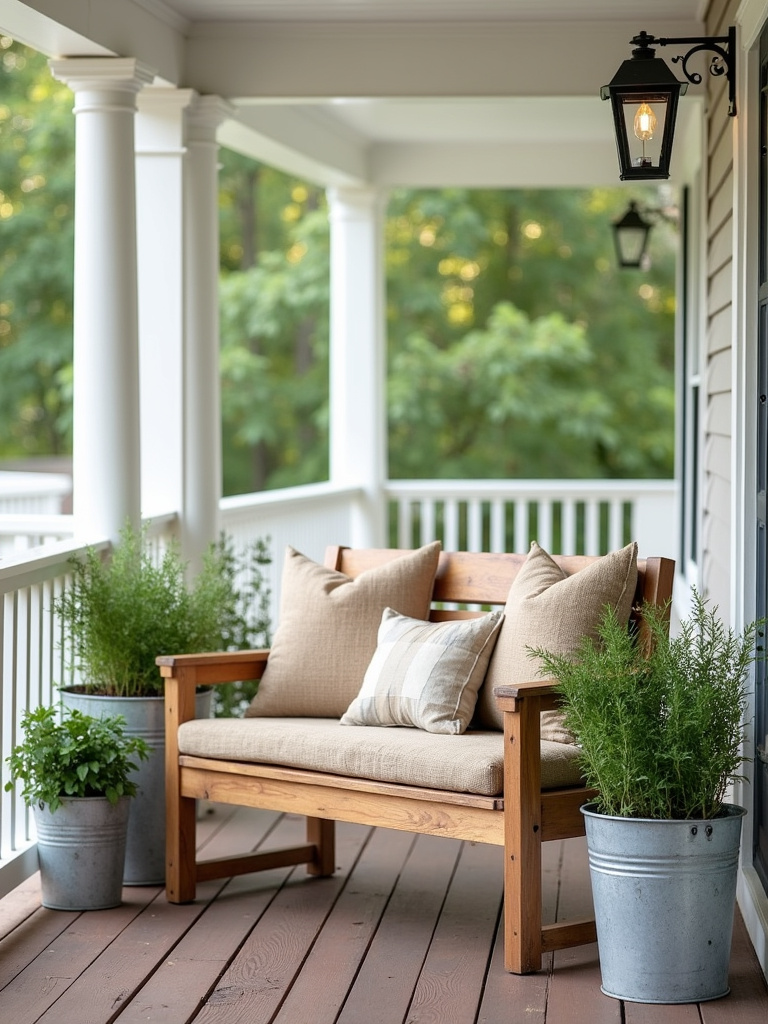
Incorporating farmhouse elements successfully requires restraint and balance in your back porch decorating. Rather than filling every surface with rustic pieces, select a few standout items – perhaps a reclaimed wood bench or a galvanized metal planter with lavender. Mix rustic elements with cleaner, more contemporary pieces to create a balanced, updated farmhouse look that feels curated rather than themed. This prevents your porch from appearing dated or overly crafted and instead creates an authentic space with character and warmth.
This all stems from our innate connection to simpler times and spaces. Farmhouse style has endured in back porch decorating because it creates environments that feel simultaneously comfortable, authentic, and timeless. By incorporating elements that reference agricultural traditions while maintaining modern comfort, you create a porch that invites relaxation while telling a visual story of heritage and simplicity.
The essence of it all is creating a dedicated dining space that extends your home’s entertaining capabilities outdoors. For back porch decorating that incorporates dining, material selection significantly impacts both aesthetics and longevity. Teak offers unparalleled natural beauty and weather resistance, developing a silvery patina over time unless oiled. Powder-coated aluminum combines lightweight practicality with rust-proof durability, making it easy to rearrange. All-weather wicker delivers traditional charm with modern durability when constructed with quality synthetic materials. Whichever material you choose, ensure seat cushions feature outdoor-rated fabrics that resist fading and moisture.
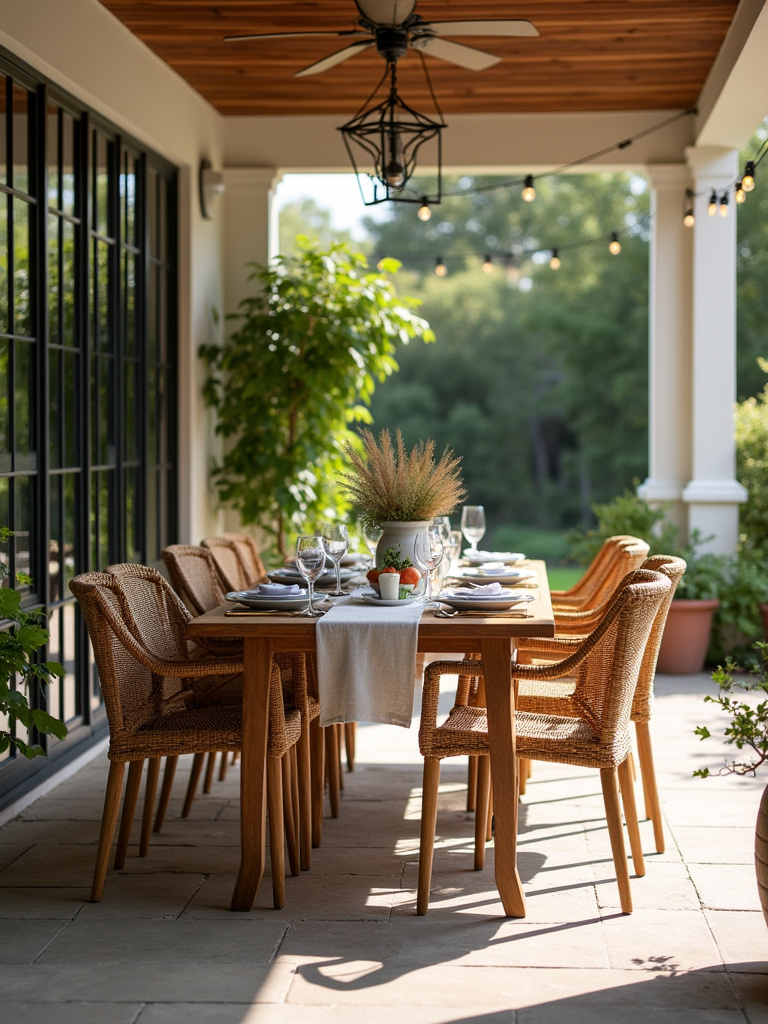
Styling your outdoor dining set involves considering both everyday use and special occasions in your back porch decorating plan. Select a dining set that complements your overall porch aesthetic – sleek and minimal for contemporary spaces, more ornate for traditional settings. Enhance the table with appropriate accessories: weather-resistant placemats, outdoor-friendly tableware, and centerpieces that withstand breezes. For evening dining, incorporate ambient lighting through lanterns, candles in hurricane glasses, or overhead string lights. Consider adding an outdoor rug beneath the dining area to define the space and add comfort underfoot.
Now, I know what you’re thinking – isn’t back porch decorating a one-time project? But here’s where your outdoor space can truly shine: by evolving with the seasons, your porch remains fresh and engaging year-round. Seasonal decorating doesn’t require complete overhauls; instead, it involves strategic adjustments to your foundation pieces. Spring might feature pastel cushions and flowering plants in bright containers. Summer calls for vibrant colors, tropical motifs, and perhaps outdoor serving pieces for entertaining. Fall invites warmer tones, textured throws, and decorative elements like dried grasses or miniature pumpkins. Winter, depending on your climate, might incorporate evergreen elements, weather-resistant holiday decorations, and perhaps outdoor-rated string lights for early evenings.
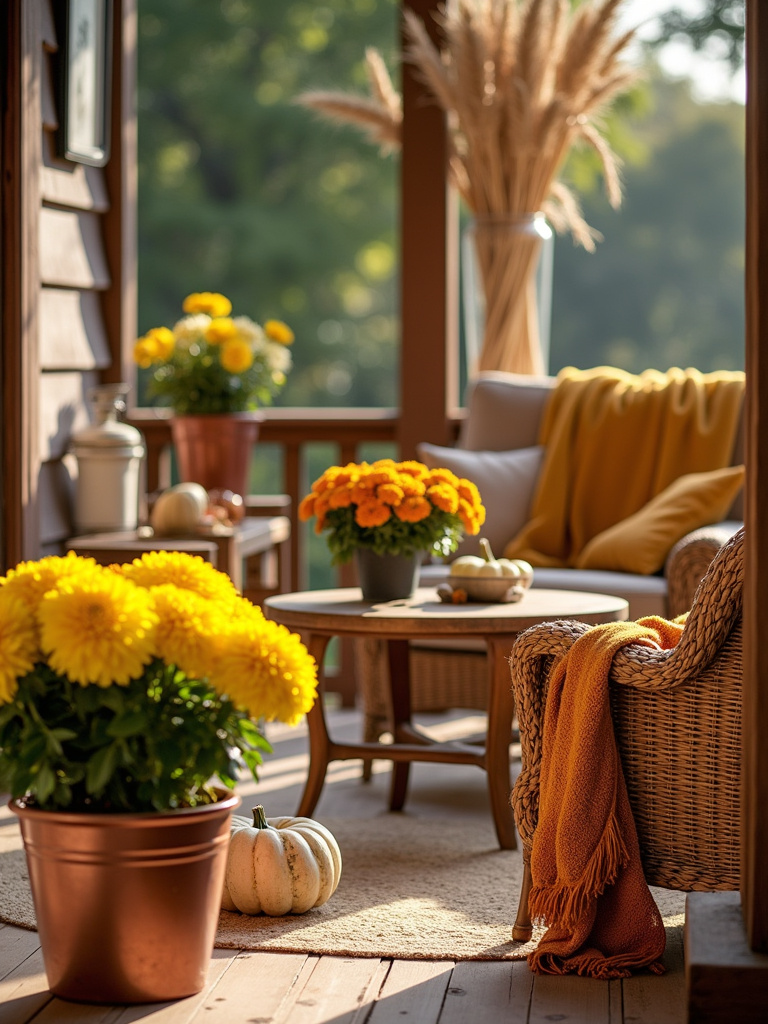
The key to successful seasonal back porch decorating lies in planning adaptable foundation pieces. Choose neutral furniture that serves as a versatile canvas. Designate specific areas for seasonal displays – perhaps a console table, a corner plant arrangement, or wall space for changeable décor. Create storage solutions for off-season items to facilitate easy transitions. Consider investing in a few high-quality pieces for each season rather than accumulating numerous inexpensive items that might deteriorate quickly in outdoor conditions.
This may seem counterintuitive, but seasonal changes to your back porch don’t just refresh your space visually – they help you connect more deeply with nature’s rhythms and the unique qualities of each time of year. This mindful approach to back porch decorating encourages you to spend more time outdoors throughout the year, appreciating the subtle shifts in light, temperature, and surrounding landscape.
When you strip it all away, back porch decorating isn’t about following trends or spending lavishly – it’s about creating an outdoor extension of your home that reflects your lifestyle and connects you with nature. The 20 ideas we’ve explored offer a framework for transforming your porch from an overlooked transitional space into a destination that draws you outdoors and enhances your daily living.
Remember that the most successful back porch decorating emerges from understanding how you want to use the space. Do you envision morning coffee surrounded by plants? Evening gatherings with friends under string lights? A quiet reading nook with a hammock swing? Let your intended activities guide your decisions about seating, lighting, accessories, and overall arrangement.
Start with the foundational elements we’ve discussed – comfortable seating, appropriate lighting, weather-resistant textiles, and meaningful plant selections. Then layer in personality through color choices, decorative accents, and seasonal touches. Your back porch will evolve over time as you discover what works best for your space and preferences.
The most beautiful back porches aren’t perfectly staged – they’re thoughtfully designed spaces that invite relaxation, connection, and appreciation of the outdoors. By implementing even a few of these ideas, you’ll create a space that enhances your home and provides a sanctuary for enjoying nature’s beauty throughout the changing seasons. Your back porch transformation awaits – what will you create?